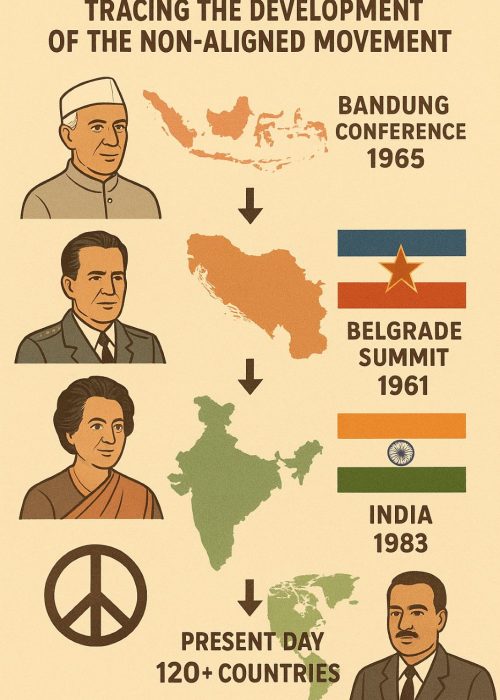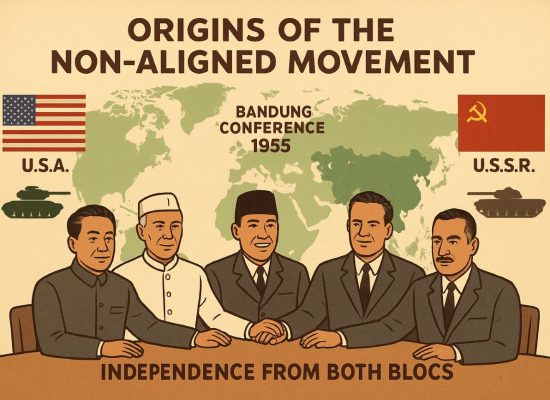1st PUC History Question and Answer – Non–Aligned Movement–Emergence of the Third world
Looking for 1st PUC History textbook answers? You can download Chapter 12: Non–Aligned Movement–Emergence of the Third world Questions and Answers PDF, Notes, and Summary here. 1st PUC History solutions follow the Karnataka State Board Syllabus, making it easier for students to revise and score higher in exams.
Karnataka 1st PUC History Textbook Answers—Reflections Chapter 12
Non–Aligned Movement–Emergence of the Third world Questions and Answers, Notes, and Summary
1st PUC History Chapter 12
Non–Aligned Movement–Emergence of the Third world
Scroll Down to Download Non–Aligned Movement–
Emergence of the Third world PDF
I. Answer in one word or sentence each.
Question 1.
Who was the first to use the word ‘Non–Aligned’?
Answer:
V.K. Krishna Menon was the first to use the word ‘Non–Aligned’ in his speech at the U.N.O. in 1953.
Question 2.
What is Non–Aligned Movement?
Answer:
Non–Aligned Movement is an international union of countries that decided to remain independent of American and Soviet blocs during the Cold War.
Question 3.
What according to Nehru is Non–Aligned Movement?
Answer:
According to Nehru, Non–Aligned Movement is dynamic neutrality to settle international problems peacefully without aligning with power blocs.
Question 4.
Where was the first summit of Non–Aligned countries held?
Answer:
The first summit of Non–Aligned countries was held at Belgrade, the capital of Yugoslavia.
Question 5.
When was the Bandung conference held?
Answer:
The Bandung Conference was held in 1955.
Question 6.
When was the Belgrade conference held?
Answer:
The Belgrade Conference was held in 1961.
Question 7.
Who was the Indian Prime Minister who participated in the Bandung conference?
Answer:
Jawaharlal Nehru, the Prime Minister of India, participated in the Bandung Conference.
Question 8.
Who was the Indonesian President who participated in the Bandung conference?
Answer:
Ahmad Sukarno, the President of Indonesia, participated in the Bandung Conference.
Question 9.
Name the Egyptian President who participated in the Bandung conference?
Answer:
Gamal Abdul Nasser, the President of Egypt, participated in the Bandung Conference.
Question 10.
Who presided over the Non–Aligned Summit at Delhi?
Answer:
Indira Gandhi, the Prime Minister of India, presided over the Non–Aligned Summit at Delhi in 1983.
II. Answer in two word or sentence each.
Question 1.
Who used the word ‘Non-Aligned’ for the first time? When?
Answer:
V.K. Krishna Menon used the word ‘Non-Aligned’ for the first time in his speech at the U.N.O. in 1953.
Question 2.
Where and when did Nehru use the word ‘Non-Aligned’?
Answer:
Jawaharlal Nehru used the word ‘Non-Aligned’ in his speech at Colombo in 1954.
Question 3.
Write the two principles of Non-Aligned Movement.
Answer:
The two principles are mutual respect for sovereignty and peaceful co-existence.
Question 4.
When was the Bandung conference held? Who presided over it?
Answer:
The Bandung Conference was held in 1955, and it was presided over by President Ahmad Sukarno of Indonesia.
Question 5.
Name the two leaders of Bandung conference.
Answer:
Two leaders of the Bandung Conference were Jawaharlal Nehru and Josip Broz Tito.
Question 6.
Who were called as ‘The Three stalwarts’ (The Trio) of NAM?
Answer:
The three stalwarts of NAM were Nehru of India, Tito of Yugoslavia, and Nasser of Egypt.
Question 7.
When was the Belgrade summit held? Who presided over it?
Answer:
The Belgrade Summit was held in 1961, and it was presided over by Josip Broz Tito.
Question 8.
Where and in which year did the Non-Aligned Movement begin?
Answer:
The Non-Aligned Movement began at Belgrade, Yugoslavia, in 1961.
Question 9.
When was the first summit of Non-Aligned Countries held? Who presided over it?
Answer:
The first summit was held in 1961 at Belgrade, and it was presided over by Josip Broz Tito.
Question 10.
Where and when was the 7th Summit of Non-Aligned countries held?
Answer:
The 7th Summit of Non-Aligned countries was held at New Delhi, India, in 1983.
III. Answer in 15 to 20 sentences (Each carries five marks)
Question 1.
Describe the objectives of Non-Aligned Movement.
Answer:
The main objective of NAM was to keep away from both USA and USSR blocs during the Cold War. It aimed to settle disputes peacefully and avoid wars. NAM opposed colonialism, imperialism, racial conflicts, Apartheid, and class discrimination. It supported human rights, disarmament, and reduction of atomic weapons. Protecting weaker nations from economic exploitation and giving financial assistance were key aims. It worked to solve problems like poverty, hunger, and illiteracy. NAM also encouraged economic self-reliance, equality, and democracy. It supported the programmes of the United Nations for world peace. Overall, its goal was peace, freedom, equality, and development for Third World countries.
Question 2.
Describe the causes for the rise of Non-Aligned Movement.
Answer:
The rise of NAM was due to political, economic, and social factors. Nationalism in Asia, Africa, and Latin America encouraged independence from power blocs. Poverty, illiteracy, and unemployment forced unity among new nations. Cold War tensions between USA and USSR threatened world peace. Developing nations also wanted to end economic exploitation and dependence on rich countries. Panchasheela principles of Nehru inspired freedom and peaceful coexistence. Able leaders like Nehru, Tito, Nasser, and Sukarno gave strong leadership. The Cold War further increased the need for a neutral force. Thus, NAM emerged for peace, equality, freedom, and self-reliance.
Question 3.
Describe the features of Non-Aligned Movement.
Answer:
Most NAM countries were economically backward with poor industries and primitive agriculture. They depended on developed nations for technology, science, and military. Rural population was large with lack of urbanization and facilities. Overpopulation, poverty, and hunger were common problems. Many depended on food imports due to shortages. Poor health services and epidemics like AIDS spread easily. Illiteracy remained high, especially among women in Africa and Asia. Heavy foreign debts forced them to borrow loans repeatedly. Large-scale migration for food and jobs was common. Water scarcity, weak armies, and unstable governments also weakened them.
Question 4.
Describe the achievements of Non-Aligned Movement.
Answer:
NAM reduced Cold War tensions and promoted peace. It, along with the UNO, helped solve issues in Korea, Vietnam, Cuba, and Kuwait. It strongly opposed Apartheid and contributed to its end in South Africa. NAM inspired treaties to reduce atomic weapons and supported disarmament. It resisted dominance of power blocs and protected independence of weaker nations. It promoted democracy and peaceful coexistence. NAM gave developing nations a common platform to raise their voice. It worked to solve problems of poverty, hunger, and illiteracy. It also encouraged self-reliance and supported UNO programmes. Thus, NAM achieved peace, equality, and unity for Third World countries.
Question 5.
What are the limitations of Non-Aligned Movement?
Answer:
NAM had no military or economic power to enforce its policies. Many members depended on developed countries for aid and weapons, weakening neutrality. Internal disputes and lack of unity reduced its strength. After Nehru, Nasser, and Tito, NAM lacked strong leadership. During the Iraq–Kuwait war, it failed to solve problems between member nations. Some Arab countries were not fully committed to NAM. While preaching disarmament, many members purchased arms from powerful nations. It failed to control terrorism and poverty effectively. Heavy debts, illiteracy, and underdevelopment continued among members. Thus, dependence, weak unity, and lack of power limited NAM’s success.
Question 6.
Write about the relationship between India and NAM.
Answer:
India played a key role in NAM’s foundation. Nehru is called the architect of NAM, and his Panchasheela principles shaped it. India hosted the 7th NAM Summit in New Delhi (1983) under Indira Gandhi. Rajiv Gandhi later demanded Nelson Mandela’s release and created the African Fund. At Belgrade, he suggested a Global Protection Fund for environment. Atal Bihari Vajpayee raised issues of terrorism and disarmament. Manmohan Singh highlighted terrorism, nuclear weapons, and the Syrian crisis at NAM summits. India also supported Palestine and opposed Israel’s aggression. Thus, India always gave leadership and actively contributed to NAM’s goals.

IV. Answer in 30 to 40 sentences (Ten Marks)
Question 1.
Trace the development of Non-Aligned Movement.
Answer:
- After World War II, the world was divided into two blocs led by the USA and USSR. Newly independent nations of Asia, Africa, and Latin America wanted to remain free from these power blocs. To protect independence and peace, the idea of non-alignment emerged.
- The Asian Relations Conference in New Delhi (1947) organized by Nehru stressed peaceful coexistence. The Bandung Conference in Indonesia (1955), attended by 29 countries, called for unity and laid the foundation for NAM. Leaders like Nehru, Nasser, Tito, and Sukarno gave strong leadership to this idea.
- The first official NAM Summit was held at Belgrade in 1961, attended by 25 nations. It adopted the policy of not joining any military bloc and accepted the Panchsheel principles. During the 1960s and 1970s, NAM supported freedom struggles, opposed colonialism and Apartheid, and promoted world peace.
- At the Algiers Summit (1973), NAM demanded a new international economic order. India under Indira Gandhi hosted the 7th NAM Summit in New Delhi (1983) where disarmament, poverty, and development were discussed. After the Cold War, NAM expanded further and focused on issues like environment, terrorism, and global cooperation.
- Today, NAM has over 120 member states and stands as the second-largest international body after the UN. From 1947 to the present, NAM has developed into a strong platform for developing nations, promoting peace, equality, and independence.

